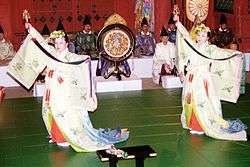神楽鈴
Japanese

| Kanji in this term | ||
|---|---|---|
| 神 | 楽 | 鈴 |
| か Grade: 3 |
らく > ぐら Grade: 2 |
すず Grade: S |
| Irregular | kun’yomi | |
Pronunciation
Noun
神楽鈴 (hiragana かぐらすず, rōmaji kagura suzu)
References
- 1988, 国語大辞典(新装版) (Kokugo Dai Jiten, Revised Edition) (in Japanese), Tōkyō: Shogakukan
- 1995, 大辞泉 (Daijisen) (in Japanese), Tōkyō: Shogakukan, →ISBN
- 2006, 大辞林 (Daijirin), Third Edition (in Japanese), Tōkyō: Sanseidō, →ISBN
This article is issued from
Wiktionary.
The text is licensed under Creative
Commons - Attribution - Sharealike.
Additional terms may apply for the media files.